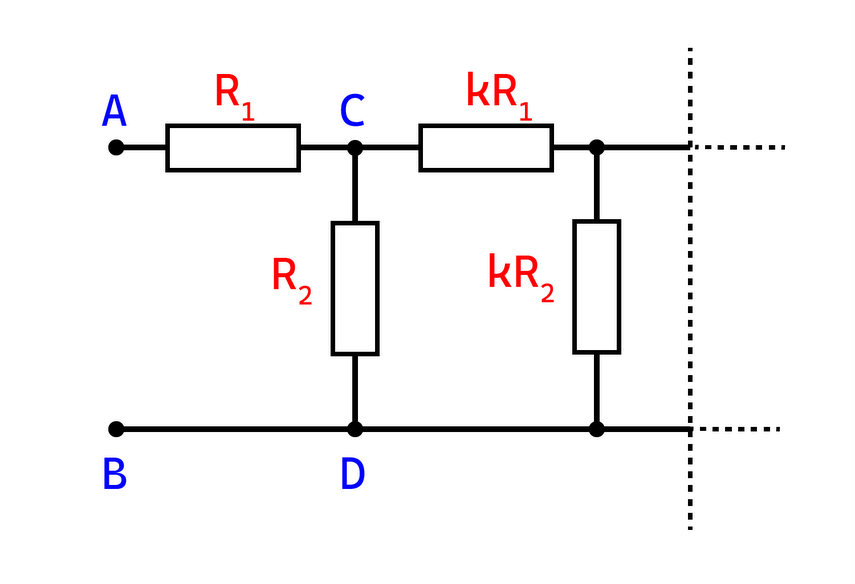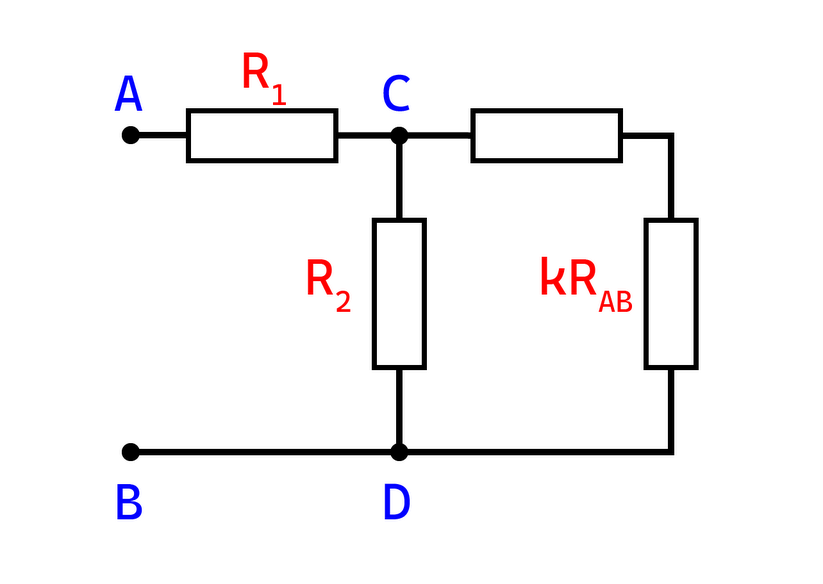
The circuit diagram shown in figure consists of a very large (infinite) number of elements. The resistances of the resistors in each subsequent element differ by a factor of k from the resistances of the resistors in the previous elements. Determine the resistance ${R_{AB}}$ between points A and B if the resistances of the first element are ${R_1}$ and ${R_2}$. (k = $\dfrac{1}{2}$)

A) $\dfrac{{{R_1} - {R_2} + \sqrt {R_1^2 + R_2^2 + 6{R_1}{R_2}} }}{2}$
B) $\dfrac{{{R_1} + {R_2} + \sqrt {R_1^2 + R_2^2 + 6{R_1}{R_2}} }}{2}$
C) $\dfrac{{{R_1} - {R_2} - \sqrt {R_1^2 + R_2^2 + 6{R_1}{R_2}} }}{2}$
D) None of these
Answer
217.8k+ views
Hint:The problem is from the electricity part of physics. We can apply the concept of parallel combination and series combination of resistance here. Use the equation for effective resistance in parallel and series combinations.
Complete answer:
We can apply the symmetry considerations and If we try to remove the first element from the given electrical circuit the resistance in between points C and D will be \[{R_{CD}} = k{R_{AB}}\].
That is, the equivalent circuit for the given circuit is drawn below.

Apply the equation for equivalent resistance in series and parallel combination. We will get,
\[{R_{AB}} = \dfrac{{{R_1} + {R_2}k{R_{AB}}}}{{{R_1} + k{R_{AB}}}}\]
By solving the quadratic equation for ${R_{AB}}$, we will get (for k = 1/2)
\[{R_{AB}} = \dfrac{{{R_1} - {R_2} + \sqrt {R_1^2 + R_2^2 + 6{R_1}{R_2}} }}{2}\]
Hence, the correct option is Option (A).
Additional Information:
Equivalent resistance for a series resistance circuit:
${R_E} = {R_1} + {R_2} + {R_3}$
Where ${R_E}$= equivalent resistance and ${R_1},{R_2},{R_3}$ = component resistance.
Equivalent resistance for a parallel resistance circuit:
$\dfrac{1}{{{R_E}}} = \dfrac{1}{{{R_1}}} + \dfrac{1}{{{R_2}}} + \dfrac{1}{{{R_3}}}$
Where ${R_E}$= equivalent resistance and ${R_1},{R_2},{R_3}$ = component resistance.
Note: Resistance is a measure of the opposition to current flow in an electrical circuit. Resistance blocks the flow of current. The S.I unit of resistance is ohms. The current decreases as resistance increases. On the other hand, the current increases as the resistance decreases.
Complete answer:
We can apply the symmetry considerations and If we try to remove the first element from the given electrical circuit the resistance in between points C and D will be \[{R_{CD}} = k{R_{AB}}\].
That is, the equivalent circuit for the given circuit is drawn below.

Apply the equation for equivalent resistance in series and parallel combination. We will get,
\[{R_{AB}} = \dfrac{{{R_1} + {R_2}k{R_{AB}}}}{{{R_1} + k{R_{AB}}}}\]
By solving the quadratic equation for ${R_{AB}}$, we will get (for k = 1/2)
\[{R_{AB}} = \dfrac{{{R_1} - {R_2} + \sqrt {R_1^2 + R_2^2 + 6{R_1}{R_2}} }}{2}\]
Hence, the correct option is Option (A).
Additional Information:
Equivalent resistance for a series resistance circuit:
${R_E} = {R_1} + {R_2} + {R_3}$
Where ${R_E}$= equivalent resistance and ${R_1},{R_2},{R_3}$ = component resistance.
Equivalent resistance for a parallel resistance circuit:
$\dfrac{1}{{{R_E}}} = \dfrac{1}{{{R_1}}} + \dfrac{1}{{{R_2}}} + \dfrac{1}{{{R_3}}}$
Where ${R_E}$= equivalent resistance and ${R_1},{R_2},{R_3}$ = component resistance.
Note: Resistance is a measure of the opposition to current flow in an electrical circuit. Resistance blocks the flow of current. The S.I unit of resistance is ohms. The current decreases as resistance increases. On the other hand, the current increases as the resistance decreases.
Recently Updated Pages
Arithmetic, Geometric & Harmonic Progressions Explained

Cartesian Form of Vector Explained: Formula, Examples & Uses

Apparent Frequency Explained: Formula, Uses & Examples

Calorimetry: Definition, Principles & Calculations

Centrifugal Force Explained: Definition, Formula & Examples

Charge in a Magnetic Field: Definition, Formula & Examples

Trending doubts
JEE Main 2026: Application Form Open, Exam Dates, Syllabus, Eligibility & Question Papers

Derivation of Equation of Trajectory Explained for Students

Hybridisation in Chemistry – Concept, Types & Applications

Understanding the Angle of Deviation in a Prism

Understanding Collisions: Types and Examples for Students

Understanding Atomic Structure for Beginners

Other Pages
JEE Advanced Marks vs Ranks 2025: Understanding Category-wise Qualifying Marks and Previous Year Cut-offs

How to Convert a Galvanometer into an Ammeter or Voltmeter

Ideal and Non-Ideal Solutions Explained for Class 12 Chemistry

Degree of Dissociation: Meaning, Formula, Calculation & Uses

Understanding Electromagnetic Waves and Their Importance

Understanding Average and RMS Value in Electrical Circuits




